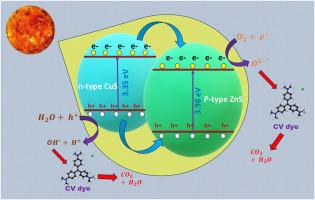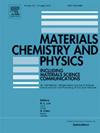Investigating the influence of CuS ratio on sun light – Driven photocatalytic performance of ZnS:CuS nanocomposites and reusability of PVA/ZnS: CuS polymer membrane
IF 4.3
3区 材料科学
Q2 MATERIALS SCIENCE, MULTIDISCIPLINARY
引用次数: 0
Abstract
In this study, ZnS and CuS nanocomposites (NCs) were synthesized using a simple and cost-effective co-precipitation method. These NCs were evaluated for their photocatalytic activity in degrading Crystal Violet dye under sunlight. ZnS:CuS nanocomposites were created using QDs in ratios of 4:1, 1:1, and 1:4. The synthesized NCs were analyzed for structural, morphological, chemical purity, and optical properties using XRD, TEM, EDAX, and UV–Vis spectroscopy. Structural analysis revealed phase-pure cubic and hexagonal structures for ZnS and CuS nanoparticles, respectively. The average crystallite sizes of the pure ZnS and CuS and their composites (4:1, 1:1 and 1:4) ratios are 1.66, 14.7, 1.90, 11.2 and 12.1 nm, respectively. TEM analysis confirmed aggregated and isolated particles, matching the SAED pattern and d-spacing values from XRD analysis. Increasing the CuS ratio in the composites enhanced absorption due to a bandgap reduction from 3.99 eV to 3.35 eV. The pure ZnS and CuS NPs and their composites in ratios of 4:1, 1:1, and 1:4 exhibited degradation efficiency of approximately 89 %, 87 %, 99 %, 97 %, and 96 % respectively over a period of 180 min. ZnS:CuS (4:1) exhibited outstanding photocatalytic activity, achieving 90 % degradation in 80 min under sunlight. Detailed discussions included the proposed photocatalytic mechanism, scavenging activity, and dosage effect. Hemolytic activity assays indicated that the synthesized NCs are nonhemolytic. The PVA and PVA/ZnS:CuS (4:1) composite membrane exhibited degradation efficiency of 63 % and 92 % respectively. ZnS:CuS (4:1) NCs, with their superior capacity for wastewater treatment, were incorporated into a PVA polymer membrane to enhance reusability and prevent photo-corrosion.

研究 CuS 比率对 ZnS:CuS 纳米复合材料日光驱动光催化性能的影响以及 PVA/ZnS:CuS 聚合物膜的可重复使用性
本研究采用简单、经济的共沉淀法合成了 ZnS 和 CuS 纳米复合材料(NCs)。研究评估了这些纳米复合材料在阳光下降解水晶紫染料的光催化活性。采用 4:1、1:1 和 1:4 比例的 QDs 制成了 ZnS:CuS 纳米复合材料。使用 XRD、TEM、EDAX 和紫外-可见光谱分析了合成的 NCs 的结构、形态、化学纯度和光学特性。结构分析表明,ZnS 和 CuS 纳米粒子分别具有纯立方和六方结构。纯 ZnS 和 CuS 及其复合材料(4:1、1:1 和 1:4)的平均结晶尺寸分别为 1.66、14.7、1.90、11.2 和 12.1 nm。TEM 分析确认了聚集和分离的颗粒,与 XRD 分析得出的 SAED 图样和 d 距值相吻合。由于带隙从 3.99 eV 减小到 3.35 eV,复合材料中 CuS 比率的增加增强了吸收。纯 ZnS 和 CuS NPs 及其比例为 4:1、1:1 和 1:4 的复合材料在 180 分钟内的降解效率分别约为 89%、87%、99%、97% 和 96%。ZnS:CuS (4:1) 表现出卓越的光催化活性,在阳光下 80 分钟内降解率达到 90%。详细讨论包括拟议的光催化机制、清除活性和剂量效应。溶血活性实验表明,合成的 NCs 不溶血。PVA 和 PVA/ZnS:CuS (4:1) 复合膜的降解效率分别为 63% 和 92%。ZnS:CuS (4:1) NCs 具有卓越的废水处理能力,将其加入 PVA 聚合物膜中可提高重复利用率并防止光腐蚀。
本文章由计算机程序翻译,如有差异,请以英文原文为准。
求助全文
约1分钟内获得全文
求助全文
来源期刊

Materials Chemistry and Physics
工程技术-材料科学:综合
CiteScore
8.70
自引率
4.30%
发文量
1515
审稿时长
69 days
期刊介绍:
Materials Chemistry and Physics is devoted to short communications, full-length research papers and feature articles on interrelationships among structure, properties, processing and performance of materials. The Editors welcome manuscripts on thin films, surface and interface science, materials degradation and reliability, metallurgy, semiconductors and optoelectronic materials, fine ceramics, magnetics, superconductors, specialty polymers, nano-materials and composite materials.
 求助内容:
求助内容: 应助结果提醒方式:
应助结果提醒方式:


